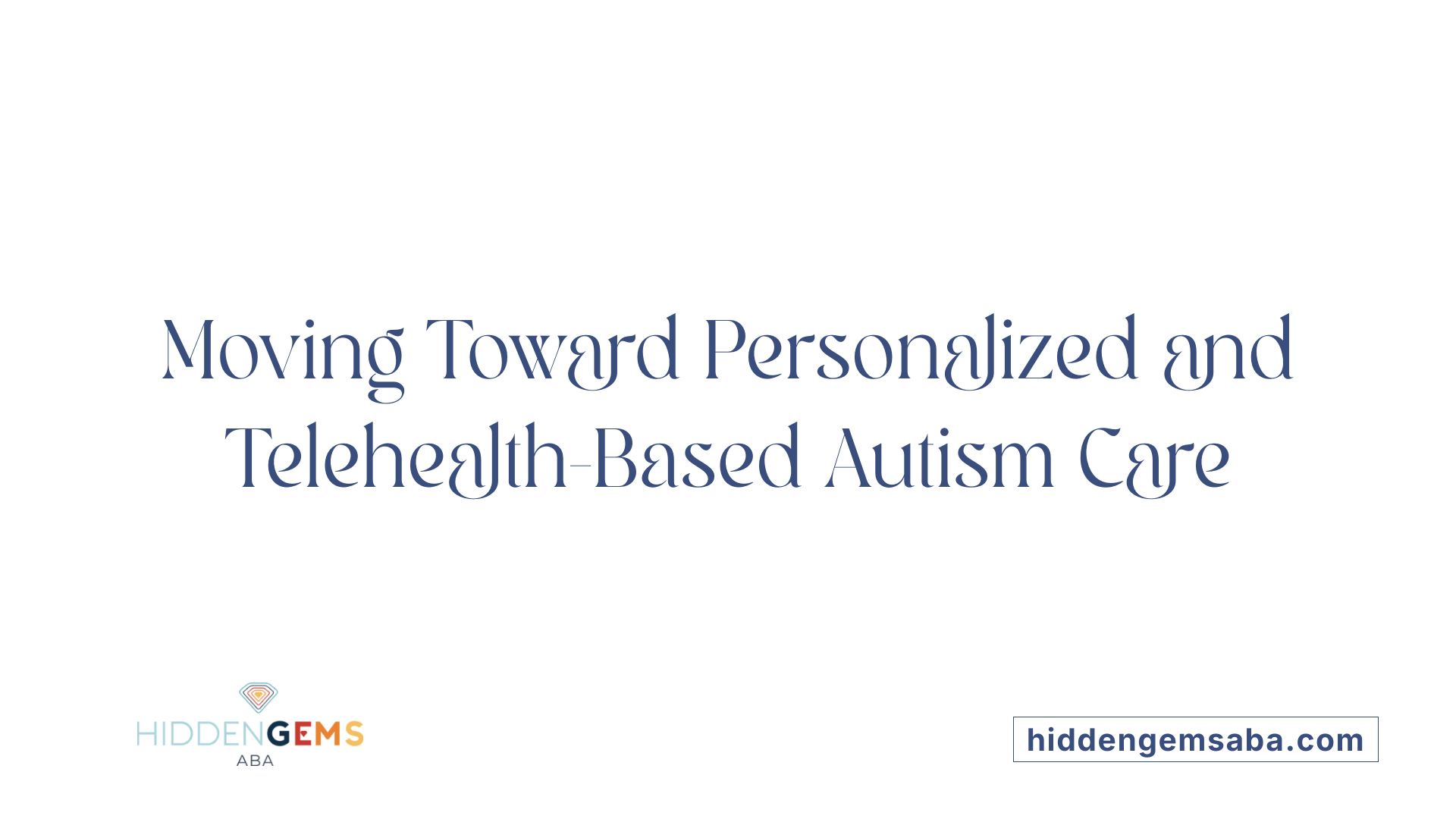Understanding the Shift Toward Personalized Autism Care
Recent developments in autism research and clinical practice are emphasizing personalized approaches that tailor interventions to individual strengths, needs, and biological profiles. This article explores how tailored treatment models, scientific discoveries, and innovative therapies are transforming the landscape of ASD care, aiming to improve outcomes and quality of life for autistic individuals.
Current State of Autism Diagnosis and Access to Care

What are the diagnostic delays and pipeline issues?
Autism diagnosis in the United States typically occurs around age 4, although early signs can be detected as early as 24 months. Despite this, many children face delays due to problems within the diagnostic process, often referred to as pipeline issues. These include limited availability of specialists, lengthy wait times for assessments, and difficulties accessing early screening programs. Such delays hinder timely intervention, which is crucial for supporting developmental progress.
What barriers do autistic individuals encounter when accessing recommended services?
Once diagnosed, autistic individuals often struggle to receive the recommended healthcare services. Barriers include long waitlists, high costs of therapies and supports, transportation challenges, limited service hours, and a scarcity of local specialists. These obstacles create significant hurdles in obtaining consistent, tailored care, impacting overall quality of life.
How do wait times, costs, and location affect access?
Extended wait times mean many families wait months or even years to start necessary interventions. The high costs associated with therapies such as behavioral, speech, or occupational therapy can be prohibitive without sufficient insurance coverage or financial resources. Additionally, geographic disparities mean that families in rural or underserved areas might lack nearby providers, further limiting access. To address these issues, there is an increased push toward more accessible, cost-effective interventions that can reach a broader population.
Moving toward personalized and flexible care options
An emerging approach focuses on customizing treatments based on each child's unique needs and family preferences. This includes considering modality preferences, service intensity, and access points. Group intervention models are employed to broaden reach, reduce costs, and promote social support. Technology plays a vital role here—telehealth services help overcome geographical barriers, enabling families to connect with providers remotely, though not all families can access such services due to technological limitations.
How digital solutions and home-based therapies contribute
Digital technologies, like online, self-guided programs such as ADEPT, provide alternative access by reducing wait times and offering flexible scheduling. Additionally, home-based therapy programs provide personalized, in-situ support within the child's familiar environment. These therapies include evidence-based practices like ABA, speech, and occupational therapy, and actively involve families to reinforce learning and development. Studies support the effectiveness of home-based interventions, especially when combined with parental participation and structured routines, fostering natural skill development and social engagement.
Personalized Care: Options, Services, and Program Innovations

What personalized care options, services, and programs are available for autistic individuals?
Personalized care for autistic individuals encompasses a wide range of tailored therapies, community supports, and organizational resources designed to meet individual needs and preferences. One prominent approach is the use of customized therapy programs such as social skills development, behavioral interventions like Applied Behavior Analysis (ABA), and sensory integration therapies. These programs aim to enhance communication, social interaction, and daily functioning.
Support services also include vocational training and employment assistance, helping autistic adults gain independence and meaningful employment. For caregivers, respite care provides short-term relief, allowing them to rest while ensuring continuous support for their loved ones. In-home assistance services help families manage daily tasks, improving overall quality of life.
Various organizations offer these supportive programs, including the Autism Society of Florida, the Center for Autism and Related Disabilities (CARD), and the Dan Marino Foundation. These organizations provide training, community integration activities, and resources tailored to individual goals.
Funding plays a significant role in accessing care, with Medicaid waivers and federal programs subsidizing therapies, in-home support, and community-based services. However, waiting lists can delay access to these benefits. To further personalize care, innovative options like telehealth services, group intervention models, and digital training platforms such as online, self-guided programs extend support accessibility.
By utilizing a combination of these services, caregivers and autistic individuals can craft comprehensive, personalized care plans that promote development, independence, and improved quality of life. Support systems are continuously evolving, driven by research and technological advances, to better meet the diverse needs of the autism community.
Scientific Breakthroughs and Biological Insights
What are the recent scientific findings related to autism subtypes and diagnostics?
Recent research has made significant strides in understanding the biological diversity within autism spectrum disorder (ASD). A pivotal study published in Nature Genetics identified four distinct autism subtypes based on both behavioral and genetic data. These subtypes include Social and Behavioral Challenges, Mixed ASD with Developmental Delay, Moderate Challenges, and Broadly Affected individuals.
Analyzing data from over 5,000 children with autism and nearly 2,000 siblings, researchers examined around 240 traits per person. They discovered that each subtype exhibits unique developmental patterns, social behaviors, co-occurring conditions, and genetic variations such as de novo mutations and inherited variants.
This complexity suggests different underlying biological mechanisms for what might appear as similar symptoms on the surface. For example, some subtypes show specific genetic pathways associated with developmental timing and brain growth. These findings challenge the old view of autism as a single condition and promote a new framework where diagnosis and treatment can be tailored more precisely.
Understanding these subtypes not only helps clarify the causes behind autism’s variability but also advances the concept of personalized medicine. Early and accurate subtype identification can lead to individualized interventions that address each person’s unique genetic and behavioral profile. Overall, these advances mark an important step toward precision diagnostics and targeted treatments, improving long-term outcomes and quality of life for autistic individuals.
Biological Foundations and Future Therapeutic Directions
What are the biological mechanisms and emerging therapies associated with ASD?
Autism Spectrum Disorder (ASD) is rooted in complex biological mechanisms that involve genetic, cellular, and immune system factors. Research has identified variations in genes that regulate synaptic proteins, affecting how neurons connect and communicate. Disruptions in neural connectivity, particularly involving the balance between excitatory and inhibitory signals — mainly glutamate and GABA neurotransmitters — are common features.
Several signaling pathways are implicated in ASD development. Notably, the mTOR pathway, which governs cell growth and synaptic plasticity; the Wnt pathway, essential for neural development; and neuroimmune responses that influence brain development and immune regulation. Mutations in specific genes such as MECP2, SHANK3, and PTEN are associated with various ASD subtypes, highlighting the disorder’s biological heterogeneity.
Emerging therapies aim to target these underlying mechanisms. Pharmacological approaches include mGluR modulators to restore synaptic balance, oxytocin to improve social behaviors, and bumetanide to influence GABAergic signaling. Innovative treatments are also exploring stem cell therapy, neurofeedback, and gene editing techniques like CRISPR to correct genetic errors. Additionally, research using animal models and stem cell systems provides insight into these molecular pathways, leading to personalized treatment strategies.
Understanding the genetic, synaptic, and immune contributions to ASD continues to shape new therapeutic approaches. As science advances, targeted interventions promise more effective management options, tailored to individual biological profiles. This progress marks a significant step toward precision medicine, helping improve outcomes and quality of life for those on the spectrum.
Innovations in Research and the Autism Care Network
The role of the Autism Care Network (ACN)
The Autism Care Network (ACN) is pioneering efforts to improve autism care across North America. As the first Learning Health Network dedicated to ASD, it links 21 institutions to enhance research, standardize treatments, and share clinical best practices.
Standardization of care protocols
One of the main objectives of the ACN is to develop uniform care guidelines for related conditions such as ADHD, anxiety, and irritability. This effort helps ensure that children receive consistent, evidence-based treatments, reducing disparities and improving overall outcomes.
Research advancements and knowledge sharing
The network facilitates the rapid exchange of research findings. Ongoing studies focus on understanding the biological underpinnings of ASD and testing new interventions. This collaborative approach accelerates the discovery process and enhances personalized care strategies.
Goals for improved person-centered care
Ultimately, ACN aims to tailor interventions to each individual’s needs. By integrating research insights and clinical data, the network supports more effective, personalized services. These efforts are designed to help autistic individuals and their families lead fuller, more connected lives.
| Aspect | Initiative | Details |
|---|---|---|
| Care Standardization | Guidelines Development | Consistent approaches for ASD and related conditions |
| Research Progress | Multi-center Studies | Faster discovery and validation of new interventions |
| Personalized Support | Family Engagement | Customized therapies based on individual traits |
Through collaborations like the ACN, advancements in research and care practices continue to make a significant impact on the future of autism spectrum disorder management.
Concluding Remarks: Towards a Personalized Future in Autism Care
The landscape of autism care is shifting toward personalized approaches that recognize each individual's unique traits, genetic background, and environmental influences. This shift is driven by recent research identifying four distinct autism subtypes, each with different developmental, behavioral, and genetic characteristics. These insights enable more targeted interventions, improving outcomes and quality of life.
Ongoing research plays a vital role in refining our understanding of the biological mechanisms behind ASD, such as mitochondrial dysfunction and immune dysregulation. Advances in genetic studies, like those published in Nature Genetics, highlight the importance of tailoring treatments based on individual biological profiles.
Supporting individuals and families remains central to this progress. Efforts include personalized therapies, home-based interventions, and community programs that foster social skills and well-being. Connecting families with resources like the Autism Care Network and innovative therapies ensures holistic, accessible care.
Looking ahead, future ASD treatments are likely to integrate genetic, metabolic, and environmental data to develop customized interventions. Technologies like telehealth, online programs, and improved diagnostic tools promise to make care more effective, flexible, and inclusive for diverse needs.
This evolving landscape offers hope for more precise, compassionate, and empowering autism care, advancing toward a future where each person with ASD receives support tailored to their unique journey.
Fostering Innovation for Personalized Autism Support
As research continues to unravel the complex biological, behavioral, and environmental factors of autism, the movement toward personalized, evidence-based care grows stronger. The integration of biological insights, innovative therapies, and family-centered services promises a future where every individual with ASD receives tailored support that maximizes their potential and enhances their quality of life.
References
- Accessible, Equitable, and Personalized Care for Autistic ...
- New study identifies biologically distinct autism subtypes, ...
- New autism discovery paves way for personalized care
- The Importance of Personalized Support and Care for ...
- A Personalized Approach to Evaluating and Treating ...
- Autism Care Network
- Home-Based Autism Therapy: Personalized Care for Your ...






